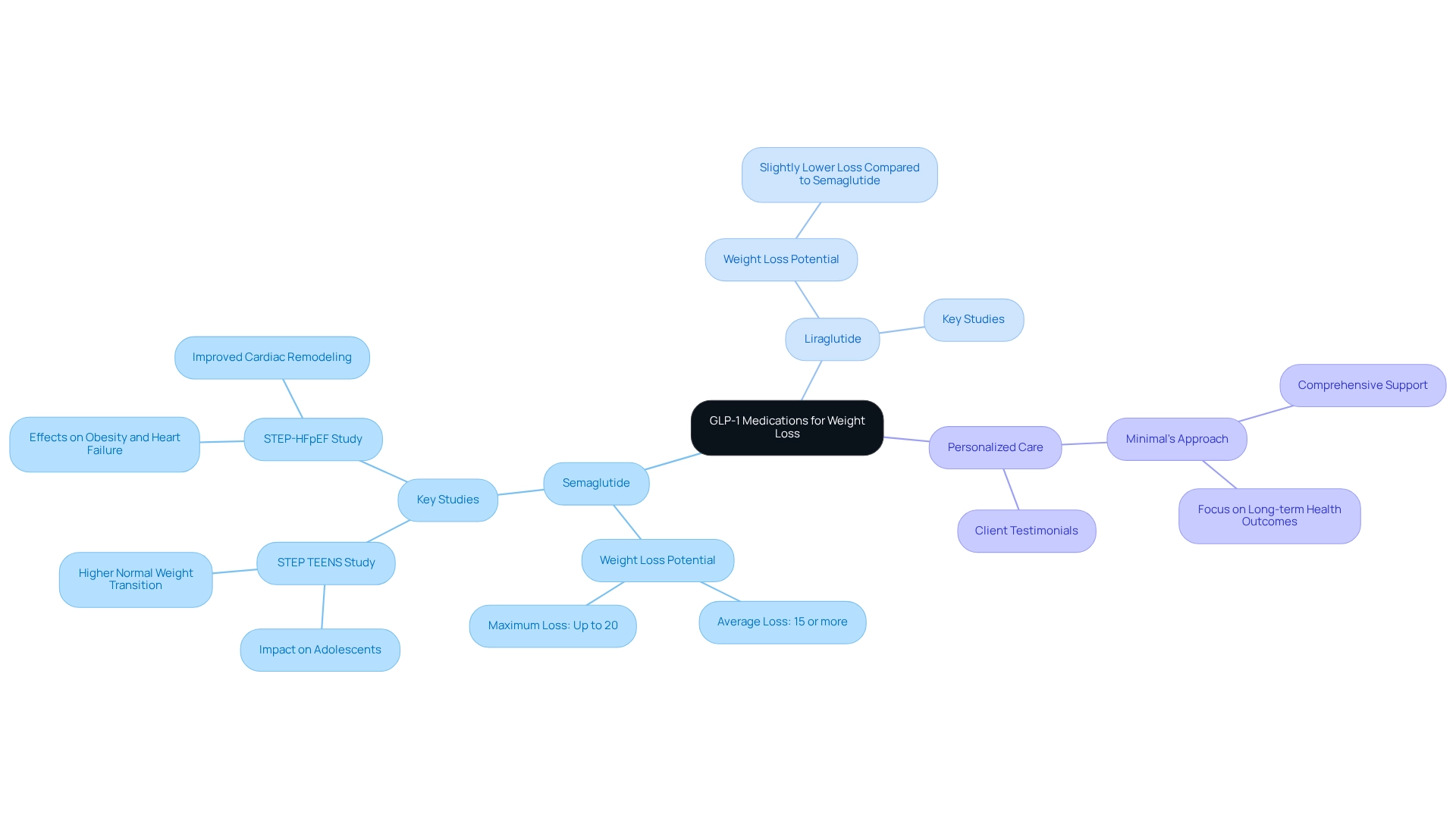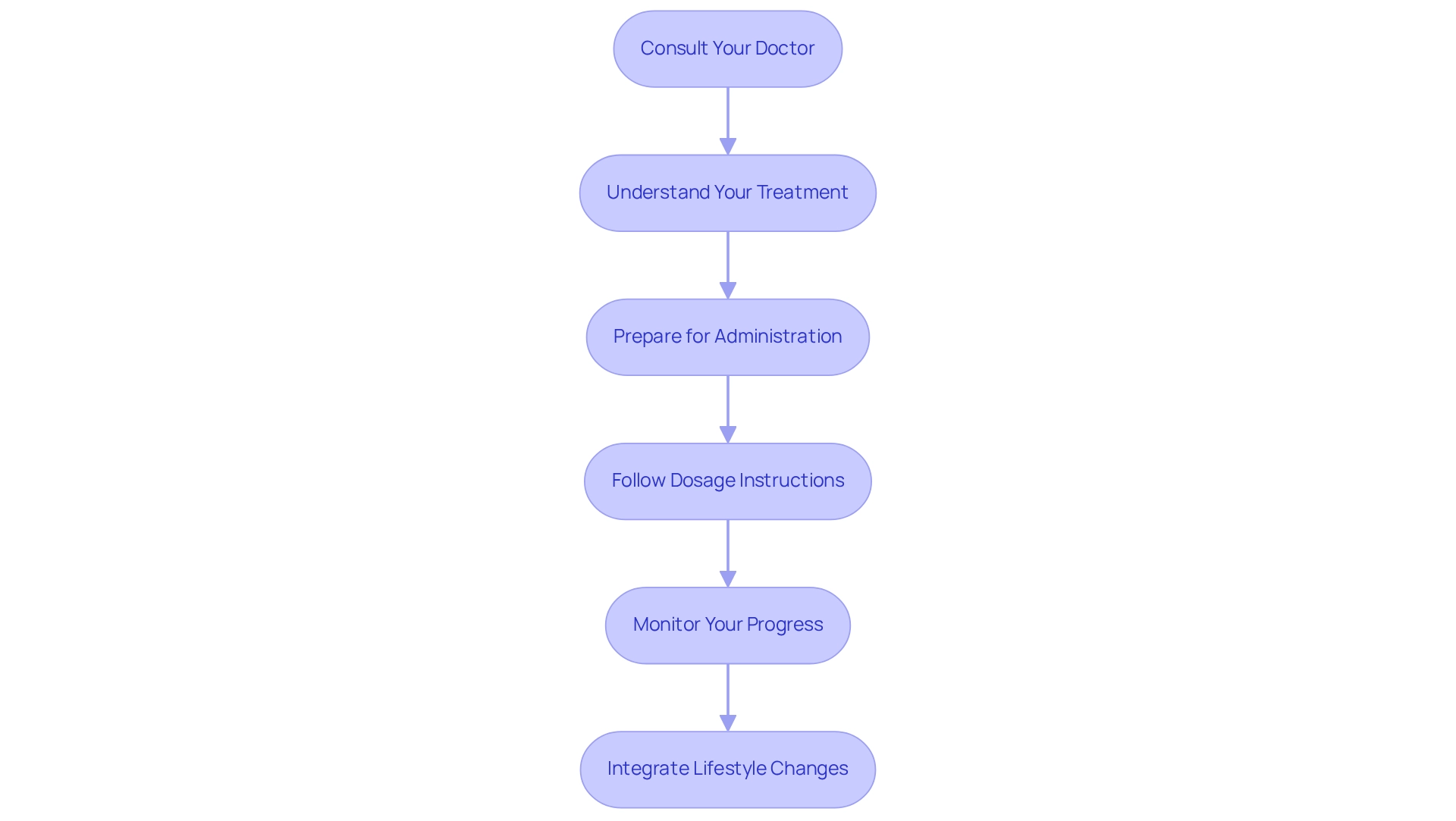Overview
If you’re feeling overwhelmed by your weight loss journey, you’re not alone. GLP-1 medications, like Semaglutide and Liraglutide, offer a compassionate solution by mimicking the natural hormones that help regulate appetite and glucose metabolism. This approach can lead to significant reductions in body mass, with some patients experiencing up to a 20% weight loss within just six months.
It’s important to remember that every journey is unique, and consulting with healthcare providers can ensure that you receive a personalized treatment plan tailored to your needs. Ongoing support is crucial to enhancing your results and helping you stay motivated.
Together, we can achieve your goals. By understanding the potential of these medications and the importance of professional guidance, you’re taking a positive step forward. Embrace this opportunity for change, and know that support is available every step of the way.
Introduction
In the journey toward effective weight management, GLP-1 medications have emerged as a truly innovative solution, transforming how individuals approach their health. These treatments, which mimic the natural hormone GLP-1, play a crucial role in regulating appetite and glucose metabolism, offering a comprehensive approach to weight loss. Many studies have shown significant weight reductions among users, leading to a growing popularity of these medications, especially among those facing obesity and related health challenges.
However, it’s important to understand the nuances of GLP-1 medications—ranging from their mechanisms of action to potential side effects—before embarking on this path. This article invites you to explore the world of GLP-1 medications, highlighting their benefits, available options, and the importance of personalized healthcare guidance. Together, we can achieve your goals for lasting weight loss success.
Understanding GLP-1 Medications: What They Are and How They Work
GLP-1 receptor agonists represent a significant advancement in weight management treatments. These medications mimic the natural hormone released in the intestines, playing a crucial role in managing appetite and glucose metabolism. By increasing insulin secretion, reducing glucagon release, and slowing gastric emptying, these therapies effectively decrease appetite and promote a sense of fullness.
This comprehensive approach not only aids in weight loss but also contributes to improved metabolic health.
Recent studies indicate that approximately 1 in 4 adults with heart disease have utilized treatments involving GLP-1, highlighting their growing acceptance in clinical practice. The effectiveness of these treatments is underscored by data showing that many patients experience substantial reductions, with some achieving decreases of up to 20% of their body weight. Typically, individuals using Ozempic or Wegovy lose 15-20% of their weight within a year, with many maintaining this reduction over time.
This statistic is particularly compelling, as it is based on outcomes from over 70,000 patients who have engaged with these therapies for at least six months.
As noted by author Priyanjana Pramanik, “GLP-1 receptor agonists are effective for reducing body mass in obesity without diabetes,” emphasizing the importance of these medications in managing body composition. Expert opinions further stress that these drugs not only assist in weight reduction but also enhance overall health outcomes by addressing obesity-related conditions. The mechanisms of action—such as appetite suppression and improved insulin sensitivity—are vital for individuals seeking sustainable weight loss.
However, it’s essential to consider the potential side effects of Wegovy, which may include nausea, vomiting, upset stomach, and fatigue, among others. Fortunately, these side effects are generally mild and often improve within the first few weeks of treatment.
Real-world examples illustrate the impact of these medications on appetite regulation. Many patients report a significant reduction in cravings and an increased ability to adhere to dietary changes, which are crucial components of effective weight management. Additionally, most adults who have used these medications obtain their prescriptions from primary care physicians or specialists, underscoring the vital role of healthcare providers in the prescribing process.
As the landscape of obesity care evolves, the importance of specific medications continues to grow, establishing them as a key option for individuals seeking effective and lasting solutions for weight reduction. Minimal’s unique combination of support, effective treatments, and a focus on long-term health outcomes positions it as a leader in the wellness industry, providing clients with the resources they need for sustainable health transformations.
Exploring Available GLP-1 Medications for Weight Loss: Options and Benefits
In 2025, several GLP-1 medications are at the forefront of body mass reduction treatments, with Semaglutide (marketed as Wegovy and Ozempic) and Liraglutide (known as Saxenda) standing out as notable options. Semaglutide has demonstrated significant effectiveness in clinical trials, with many participants achieving a reduction of 15% or more of their initial body mass. Remarkably, clients can lose up to 20% of their mass, based on data from over 70,000 patients who have engaged in these treatments for at least six months. This highlights the potential for considerable health improvements.
While Liraglutide is effective, it typically results in a slightly lower mass loss compared to Semaglutide. Both medications work by enhancing feelings of fullness and curbing appetite through the action of GLP-1, which helps individuals adhere to a calorie-restricted diet. Recent studies, including the STEP-HFpEF trials, have underscored the benefits of Semaglutide, particularly its effects on GLP-1 in managing body mass and improving cardiac health among those with obesity and heart failure.
Recent research has also focused on comparing the effectiveness of Semaglutide and Liraglutide, both of which are GLP-1 receptor agonists. For instance, the STEP TEENS study assessed the impact of Semaglutide on adolescents with obesity, revealing that those receiving Semaglutide had a greater chance of reaching a normal weight range or transitioning from obesity to being overweight compared to the placebo group. This underscores the importance of early intervention in younger populations.
Understanding the differences among these therapies is crucial for individuals seeking the most suitable option for their weight loss journey. Minimal offers comprehensive care without the need for insurance, guided by a dedicated team that supports clients throughout their transformation. This unique blend of support, effective treatments, and a focus on long-term health outcomes positions Minimal as a leader in the wellness industry, making it a preferred choice for those seeking sustainable health transformations.
As Dr. Chance Miller emphasizes, “Clients appreciate the personalized attention from a dedicated care team, which includes physicians who emphasize transformative care.” With ongoing clinical trials and emerging data, the landscape of specific therapies continues to evolve, offering promising avenues for effective management of body mass, complemented by Minimal’s holistic approach to personalized reduction solutions and comprehensive health care.
Testimonials from satisfied clients further illustrate the success of this approach, showcasing real-life transformations and the effectiveness of the treatments provided.
Consulting Healthcare Professionals: The Importance of Personalized Guidance
Before embarking on your weight loss journey, discussing your plans with a healthcare expert is essential. At Minimal, this initial consultation provides an opportunity for a thorough assessment of your medical history, current health conditions, and any potential interactions with existing treatments. Our caring healthcare providers are dedicated to identifying the most suitable GLP-1 therapy tailored to your unique needs, ensuring that the treatment aligns with your overall health goals.
Personalized guidance from a healthcare professional not only enhances the effectiveness of the medication but also facilitates ongoing monitoring of your progress throughout the treatment. Evidence shows that individuals who receive personalized healthcare guidance are more likely to achieve significant weight loss results. For example, a study conducted from January 2020 to December 2021 revealed that patients who engaged in regular consultations with their healthcare providers experienced better outcomes compared to those who did not.
Moreover, case studies underscore the importance of personalized healthcare in managing body mass. One notable research study, titled ‘Need for Routine Obesity Screening in Primary Care,’ advocates for regular evaluations of patients’ body mass by general practitioners and emphasizes the value of personalized counseling. This proactive approach is crucial for effective obesity management, highlighting the necessity for healthcare professionals to actively address body issues during patient visits.
As Dr. Chance Miller notes, “Clients appreciate the personalized attention from a dedicated care team at Minimal, which includes physicians who emphasize transformative care.”
At Minimal, our program for reducing body mass begins with a consultation to evaluate your health and identify the optimal treatment plan, including possible prescription alternatives such as Semaglutide. We combine treatments with personalized fitness and nutrition plans to promote long-term success.
In summary, consulting a healthcare professional before starting GLP-1 medications is not merely a precaution; it is a fundamental step towards achieving sustainable body mass reduction. If you need additional assistance, you can connect with Minimal Support in three ways:
- Phone: (872) 228 – 2358
- Email: [email protected]
We are here to ensure you receive the finest possible support, greatly enhancing your chances of success on your journey to healthier living.
Step-by-Step Guide to Using GLP-1 Medications for Weight Loss
- Consult Your Doctor: Begin your journey by scheduling a meeting with your healthcare provider to discuss your goals for reducing body mass. This conversation is crucial in determining if Mounjaro is the right treatment for you, considering your medical history and individual needs. Mounjaro represents an innovative approach to weight loss, targeting essential pathways in the body through GLP-1 to help manage appetite and food intake, making it a promising option for effective weight management.
- Understand Your Treatment: Take a moment to familiarize yourself with the prescribed medication for diabetes. Understanding the dosage, how to administer Mounjaro (which is a once-weekly injection), and the timing of doses is vital for ensuring its effectiveness. As Ryan A. Costello notes, ‘The role of GLP-1 is to reduce serum glucose levels and thus regulate metabolism in impacted patients.’
- Prepare for Administration: If Mounjaro is prescribed as an injectable form, gather all necessary supplies, including alcohol wipes, syringes, and the medication itself. Learning how to prepare and administer the injection correctly is essential to avoid complications and ensure proper dosing. A case study on GLP-1 dosing and administration highlights the differences between injectable and oral formulations, discussing patient preferences regarding dosing schedules.
- Follow Dosage Instructions: It’s important to adhere strictly to the prescribed dosage and schedule. Consistency is key to achieving the results you desire. If you miss a dose, please consult your healthcare provider for guidance on how to proceed without jeopardizing your treatment plan. Be aware that low persistence rates may occur due to supply shortages and side effects, which can impact your progress in losing weight. Mounjaro may cause mild side effects like nausea or injection site reactions, especially initially.
- Monitor Your Progress: Keep a detailed record of your weight loss journey and any side effects you may encounter. Regular check-ins with your healthcare provider are essential for adjusting your treatment plan as needed and ensuring you stay on track to meet your goals. Clients can lose up to 20% of their body mass, based on data from over 70,000 participants who have engaged with this treatment for at least six months, underscoring the effectiveness of options like Mounjaro.
- To enhance the benefits of GLP-1 medications, consider integrating lifestyle changes such as healthy eating habits and regular physical activity into your daily routine. This holistic approach not only supports weight loss but also improves overall well-being, making your journey more sustainable. When combined with a balanced diet and exercise, Mounjaro offers a comprehensive strategy for weight management. Remember, we’re here for you—together, we can achieve your goals.
Potential Side Effects and Considerations When Using GLP-1 Medications
GLP-1 treatments are generally well-accepted, though some individuals may experience side effects. The most common adverse effects include nausea, vomiting, diarrhea, and constipation. While these symptoms can be uncomfortable, they usually diminish over time as the body adapts to the treatment.
It’s important for patients to communicate any severe or persistent side effects to their healthcare provider promptly.
At Minimal, how do we manage these side effects?
At Minimal, we understand that managing these side effects is an integral part of our comprehensive weight loss prescription program. Our tailored therapies, supported by professional fitness coaches and dietitians, empower clients to navigate the challenges related to weight-loss treatments effectively.
Additionally, we offer services such as breathwork, acupuncture, and continuous glucose monitoring to enhance our clients’ overall wellness.
What should clients be aware of regarding blood sugar levels?
Users should be cautious about the risk of low blood sugar, especially if they are also using other diabetes treatments. Consistent monitoring of blood sugar levels and open dialogue with healthcare professionals can greatly assist in managing these potential risks.
Statistics reveal that a significant portion of patients face gastrointestinal issues, with nausea and vomiting being particularly common among users of certain GLP-1 treatments. In fact, studies indicate that these side effects can affect many individuals, but they often resolve as treatment continues. Moreover, clients at Minimal can lose up to 20% of their mass, based on insights from over 70,000 patients who have been involved for at least six months, highlighting the effectiveness of these treatments in managing body mass.
How does a supportive healthcare team assist?
Real-world experiences underscore the importance of a supportive healthcare team in managing these side effects. A collaborative approach, involving primary care providers, diabetes educators, and pharmacists, has been shown to improve glycemic control and reduce adverse reactions from these GLP-1 agonists.
This teamwork not only enhances patient outcomes but also fosters a deeper understanding of how to navigate the complexities of treatment. Importantly, instances of overdose with receptor agonists typically lead to intense gastrointestinal symptoms but no major complications, emphasizing the necessity of diligent management.
In conclusion, while these treatments can cause side effects, proactive management strategies and a strong support system at Minimal can help patients achieve their reduction goals effectively. As Dr. Chance Miller emphasizes, clients appreciate the personalized attention from a dedicated care team, which is essential in navigating the complexities of treatment.
Furthermore, the FDA and EMA have determined that concerns about a causal link between incretin-mimetic drugs and acute pancreatitis are not supported by existing data, reassuring patients about the safety profile of these treatments.
Integrating Lifestyle Changes: Nutrition and Exercise for Enhanced Results
To enhance the efficacy of treatments such as Mounjaro and Wegovy on your journey to reduce body mass, it’s crucial to integrate significant lifestyle adjustments into your overall strategy. Mounjaro, a state-of-the-art medication for shedding pounds, works by mimicking natural hormones that control appetite and food consumption, helping to decrease hunger and enhance feelings of satiety. Similarly, Wegovy, which contains semaglutide, stimulates GLP-1 receptors in the brain to promote fat reduction by decreasing appetite.
Mounjaro is administered as a once-weekly injection under the skin of the stomach, thigh, or upper arm. Your healthcare provider will guide you on how to inject it properly. Remember to inject it on the same day each week and follow all dosage guidelines provided by your doctor.
Wegovy is also given via a subcutaneous injection once a week, using a pre-filled pen for ease of use.
Begin by focusing on a balanced diet that emphasizes whole foods, including a variety of fruits, vegetables, lean proteins, and whole grains. Working with a nutritionist can help you develop a personalized meal plan tailored to your specific reduction objectives, ensuring that your dietary selections support your treatment with Mounjaro or Wegovy.
In addition to dietary modifications, consistent physical exercise plays a vital role in improving fat reduction results. Engaging in activities such as walking, strength training, or aerobic exercises can significantly amplify your efforts. Aim for at least 150 minutes of moderate-intensity exercise weekly, as this amount of activity is linked to enhanced fat reduction outcomes and overall health benefits.
Patients should work towards at least 5 days a week of 30 minutes of moderate-intensity aerobic physical activity over a period of 3 to 6 months to optimize their results.
Studies suggest that incorporating these lifestyle changes not only aids in reducing excess body mass but also leads to improved health and wellness. For instance, individuals who maintain a regular exercise regimen alongside medications like Mounjaro and Wegovy are more likely to achieve lasting weight loss. Furthermore, research indicates that those who experience weight regain after stopping these treatments often face greater challenges in controlling their body size, highlighting the importance of ongoing lifestyle changes.
This aligns with findings showing that a 1% increase in weight correlates to a 2.3% heightened risk for individuals with type 2 diabetes.
Integrating expert suggestions, such as emphasizing nutrient-rich foods and maintaining an active lifestyle, can enhance the effectiveness of GLP-1 treatments. As Ken Goldman, Lead Equity Research Analyst for the U.S. Food Producers and Food Retailers sectors, notes, “Overall, we think that if GLP-1s start to make a meaningful difference in consumption patterns, grocers will be hurt less than packaged food companies.” Success stories from individuals who have successfully combined these strategies with their treatment highlight the potential for transformative results.
By committing to these lifestyle changes, you can significantly boost your chances of achieving and sustaining your weight reduction goals. Additionally, the limitations of traditional lifestyle modification approaches underscore the necessity for more accessible and effective interventions to support individuals struggling with obesity in various settings.
Potential side effects of Mounjaro include nausea, vomiting, diarrhea, bloating, injection site reactions, headaches, dizziness, and mild fatigue. Wegovy may also cause similar side effects, such as nausea, vomiting, upset stomach, and diarrhea. It is essential to consult your healthcare provider for personalized guidance on treatments and lifestyle adjustments.
The Role of Ongoing Support and Monitoring in Your Weight Loss Journey
Continuous support and monitoring are essential for achieving successful weight loss with GLP-1 medications, such as Wegovy. Regular check-ins with your healthcare provider not only help track your progress but also allow for timely adjustments to your treatment plan, addressing any concerns that may arise. Have you ever wondered how regular interactions with healthcare providers can impact your results? Research shows that individuals who engage consistently with their providers achieve notably better outcomes, with many losing up to 20% of their body mass over time.
Moreover, the projected increase in healthcare expenses due to obesity, estimated at $149 billion each year, highlights the broader implications of effective body mass management. This is a significant concern that we can tackle together.
In addition to medical supervision, participating in a support group or collaborating with a fitness coach can enhance motivation and accountability. Connecting with others who share similar goals nurtures a sense of belonging and provides crucial support during the gradual journey of weight loss. Research indicates that individuals who lost 20 kg or more maintained their weight reduction more effectively than those who dropped less than 10 kg, underscoring the importance of ongoing support.
Health professionals emphasize that continuous assistance is not just beneficial; it is vital in navigating the challenges of reducing body mass. Case studies reveal that patients using medications like Wegovy, combined with regular monitoring and support systems, report higher satisfaction and success rates. For instance, Wegovy mimics the function of the hormone GLP-1 to regulate appetite, showing considerable effectiveness in reducing body mass when paired with a lower-calorie diet and increased physical activity.
Dr. Chance Miller, a physician, shares, “Clients appreciate the personalized attention from a dedicated care team at Minimal, which includes physicians like me, who emphasize transformative care.”
Furthermore, individuals who followed very-low-energy diets (VLEDs) or lost 20 kg or more sustained significantly greater reductions compared to those who adhered to high balanced diets (HBDs) or lost less than 10 kg. By sharing experiences and strategies within a supportive environment, individuals can gain valuable insights that propel them toward their goals. Ultimately, a robust support system can profoundly influence the trajectory of your weight loss journey, making it a key component of effective health management. Together, we can achieve your goals and foster a healthier future.
Conclusion
As we explore GLP-1 medications, it becomes evident that these innovative treatments offer a comprehensive approach to weight management by mimicking the natural hormone GLP-1. Medications like Semaglutide and Liraglutide have shown remarkable efficacy in facilitating significant weight loss while also improving metabolic health. Many patients can achieve reductions of up to 20% of their body weight, highlighting the potential of GLP-1 medications as a viable option for those facing obesity.
While the benefits are compelling, it is crucial to approach GLP-1 medications with a clear understanding of their mechanisms, potential side effects, and the importance of personalized healthcare guidance. Have you considered how consulting with healthcare professionals can ensure you receive tailored support? This support is vital for maximizing the effectiveness of these treatments. Integrating lifestyle changes, such as nutrition and exercise, further enhances your weight loss journey, transforming it into a holistic endeavor that goes beyond medication alone.
Ultimately, ongoing support and monitoring are essential for successful weight management with GLP-1 medications. Regular check-ins with healthcare providers and participation in supportive communities can foster accountability and motivation, significantly improving your outcomes. As you embark on your weight loss journey, remember that embracing the full spectrum of support—medical, nutritional, and emotional—will empower you to achieve lasting results and enhance your overall well-being. Together, we can achieve your goals, and we’re here for you every step of the way.
Frequently Asked Questions
What are GLP-1 receptor agonists and how do they work?
GLP-1 receptor agonists are medications that mimic a natural hormone released in the intestines, helping to manage appetite and glucose metabolism. They increase insulin secretion, reduce glucagon release, and slow gastric emptying, which decreases appetite and promotes a sense of fullness.
What are the benefits of using GLP-1 receptor agonists for weight management?
These medications aid in weight loss and improve metabolic health. Patients typically experience substantial weight reductions, with some losing up to 20% of their body weight. They also enhance overall health outcomes by addressing obesity-related conditions.
How effective are GLP-1 receptor agonists in weight loss?
Studies show that many patients using GLP-1 receptor agonists, such as Ozempic or Wegovy, lose 15-20% of their weight within a year, with many maintaining this reduction over time. This data is based on outcomes from over 70,000 patients who have used these therapies for at least six months.
What are some potential side effects of GLP-1 receptor agonists?
Potential side effects may include nausea, vomiting, upset stomach, and fatigue. However, these side effects are generally mild and tend to improve within the first few weeks of treatment.
Who typically prescribes GLP-1 receptor agonists to patients?
Most adults who use these medications obtain their prescriptions from primary care physicians or specialists, highlighting the important role of healthcare providers in the prescribing process.
What specific GLP-1 medications are available for weight loss?
Notable GLP-1 medications include Semaglutide (marketed as Wegovy and Ozempic) and Liraglutide (known as Saxenda). Semaglutide has shown significant effectiveness, with many participants achieving a reduction of 15% or more of their initial body mass.
How do Semaglutide and Liraglutide compare in terms of effectiveness?
Semaglutide typically results in greater mass loss compared to Liraglutide. Both medications enhance feelings of fullness and help curb appetite, facilitating adherence to a calorie-restricted diet.
What is the significance of early intervention with GLP-1 medications?
Research, including the STEP TEENS study, indicates that early intervention with Semaglutide in adolescents with obesity can increase the chances of reaching a normal weight range or transitioning from obesity to being overweight compared to those receiving a placebo.
How does Minimal support individuals seeking weight loss with GLP-1 medications?
Minimal offers comprehensive care without the need for insurance, supported by a dedicated team that assists clients throughout their transformation, focusing on long-term health outcomes.



















